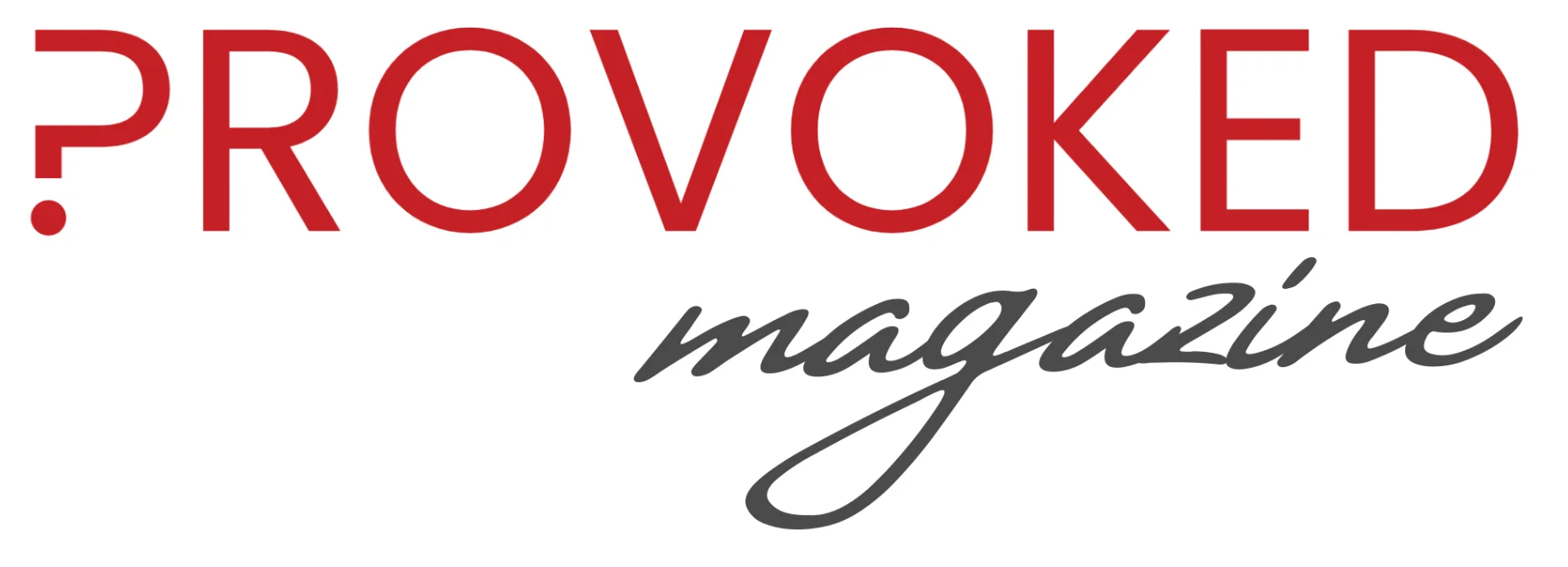This piece was written by one of our dear readers—a woman with something real to say. Each month, we handpick the best submissions for Dear Reader because we’re after that PROVOKED bite: truth, intelligence, and heart. These stories come from women our age—women who’ve lived enough to know better and still care enough to tell it anyway. Because being seen and heard matters. Because storytelling is how we stitch ourselves to one another. And because when one woman speaks her truth, another finally recognizes her own. — Susan Dabbar, Editor in Chief
One woman’s experiment with data, hormones, and perspective—turning midlife into a design project instead of a decline.
I dreaded going gray because I thought it meant fading away. Turns out, it made me magnetic. More people noticed me, more conversations sparked, and I felt strangely visible. That flip taught me something big: Maybe aging isn’t an inevitable decline. Maybe it’s a choice. Maybe it’s data.
For years, I’d hidden the silver because I believed it signaled invisibility. But the moment I stopped dying my hair black, I started standing out. The very thing I feared became proof that stepping into my truth—not hiding it—attracts more authentic connections.
That lesson carried over into my health. If gray hair could flip my story of aging, maybe the rest of aging wasn’t about decline either.
From Gadgets to What Actually Matters
Earlier this year, I dove headfirst into the biohacking world. I flew to the big conference in Austin, geeked out on panels, and came home with an idea to experiment with an arsenal of tools: a continuous glucose monitor (CGM), a gut intelligence test (testing saliva, blood, and stool), and wearables tracking sleep, strain, and recovery. I was lit up by the idea that I could engineer my vitality the same way I’ve engineered skyscrapers and hospitals for decades.
Then a 10-day international trip threw my routine off track. My old self would’ve called that failure—proof I couldn’t stick to a commitment. But after years of responding to jobsite crises, I’m rethinking how I show up and the emotions I choose to feel daily. I didn’t want to collect numbers for the sake of numbers. I wanted an intention. What did this data mean for me, specifically, as a woman turning 50 and realizing that perspective itself is part of the experiment?
That’s when I hit a hard truth most glossy brochures won’t tell you: The “evidence” behind many protocols was built on men. It wasn’t until 1993 that U.S. policy required the inclusion of women in NIH-funded clinical research. For decades, diagnostics and dosing norms were calibrated on male physiology. We’re still living with that hangover.
Women Need a Different Rulebook
Even today, women remain underrepresented in trials. In some major disease areas, women are ~51 percent of patients but only ~41 percent of clinical trial enrollees. That mismatch affects how well treatments and thresholds translate to women’s bodies.
So when a “one-size-fits-bros” hack doesn’t land for you, it’s not you—it’s the data. Hormones shift by the week and by the decade. Perimenopause isn’t a bug in the system; it is the system. Protocols validated on male baselines can backfire for women, especially around fasting, sleep, and stress regulation. Better inputs mean better outcomes. That’s not decline—it’s redesign.
The Glucose Revelation: Start with the Greens
No doctor had ever told me the sequence of eating could change my glucose response to the same meal. Yet emerging research proves it can. So, as a way to jump back on my biohacking bandwagon, I’m monitoring my CGM to see it for myself: eating fiber and vegetables first, then protein and fat, and saving carbs for last can blunt post-meal spikes. Small shift, big effect. Studies have observed lower postprandial glucose and insulin when carbs come last (or vegetables first), including in women.
For me, this discovery isn’t abstract. Diabetes runs in my family, and I’d rather approach my 50s through prevention than wait for a cure. Food order might sound simple, but it could be the difference between decline and design.
How is it 2025 and many of us are just learning this? Legacy medicine worked from snapshots (annual labs, symptom visits). It wasn’t looking for patterns a wearable can surface in days. New data gives us more than numbers—it gives us leverage.
What Doctors Miss When They Only Look Once a Year
Traditional care is like managing a high-rise with one annual inspection: too little, too late. Biohacking tools flip that script—continuous glucose, nightly sleep, daily HRV, all messy, personal, alive. For women, this matters even more because hormonal transitions (hello, perimenopause) constantly rewrite our baselines.
If we can instrument buildings with sensors running 24/7, why are we still managing women’s health on calendar reminders and guesswork? Real-time data doesn’t just measure decline—it helps us make choices.
AI Needs Our Data—and Yes, That’s Creepy
AI learns from data. If most historical health datasets skew male, the algorithms guiding future care will “understand” men better than women. That’s a problem—and an opening. The more women track and (ethically) share our baselines, the more we close the gender data gap and force models to learn from our physiology.
And yes, it’s creepy—but necessary. Do I want Big Tech knowing how many carbs I ate before bed? Not really. But if we don’t engage, who will teach the algorithms what female vitality actually looks like? Refusing to participate keeps us invisible inside the very systems shaping tomorrow’s medicine.
Aging Is a Choice. Not Decline.
The wellness industry sells fear: wrinkles, weight, menopause. Biohacking, reframed for women, is the opposite. It’s not about pretending to be 25. It’s about deciding how we feel inside the bodies we have now.
My gray hair doesn’t mark decline, it marks choice. My data doesn’t tell me to be younger, it tells me to be awake. The more of us feeding high-quality, female-specific data into the loop, the more we engineer a medical future that actually sees us. A spike in glucose today might show up as a wrinkle tomorrow. Prevention beats cure—but more data means better cures too, if we need them.
A Call to Women at the Threshold
Treat midlife as your most radical experiment. Ask the questions your doctor never did. Try food sequencing and see what your own curve does. Share your baselines—securely, intentionally. Advocate for clinicians who will read your graphs, not just nod at them.
Because the real hack isn’t anti-aging. If the world expects us to fade, then maybe the most radical thing we can do is glow—in silver, in data, and in the future we’re daring to engineer.
*******
MEDICAL ADVICE DISCLAIMER
DISCLAIMER: This website does not provide medical advice. For health or wellness-related content, SFD Media LLC emphasizes that information about medicines, treatments, and therapeutic goods (including text, graphics, and images) is provided for general information only. No material on this site is intended to substitute for professional medical advice, diagnosis, or treatment. Users are advised to independently evaluate and verify the accuracy, reliability, and suitability of the information before relying on it. You should not rely on the content as a substitute for professional medical advice. Consult with a physician or other health care professional for any health concerns or questions you may have. SFD Media LLC is not responsible for any action taken based on the information provided on this website. The use of any information provided on this website is solely at your own risk.


Great article Annmarie: Sometime ago I read your book Engineered Miracles and thought Jose would enjoy reading it as well and he did! He found it in extremely interesting the way you combined engineering principles to addressing every day issues.
I hope you’re doing well and look forward to the next time our paths cross.
Eileen, so nice to see you here in the comments. We are lucky to have Annemarie writing for us. Her combination of engineering smarts and practical approach to things women care about are a perfect match for PROVOKED. It was such a fortuitous meeting at the Maritime Awards Dinner just a few months ago where we met. Thanks for reading and contributing to our community! —susan
Women are the original bio-hackers. We all start by tracking our periods, and if we’re fertile AFABs having sex with AMABs, we have that monthly spike of stress if that tracking goes awry.
“Am I pregnant?”
I was so glad to have that surgically altered early, but the monthly cycle still ruled my biology in other ways, and I still had to track it.
I, too, had to start tracking everything when a degenerative nerve disease starting acting up and also affected my central nervous system and gut. Finding other perimenopausal women tracking themselves helped me to feel less alone in my quest for good health.